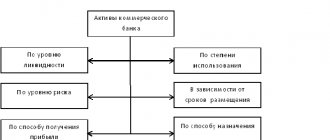Negative net assets
A negative scenario for a company that has not taken measures to overcome the negative value of the indicator under consideration is liquidation.
This will happen if for a long time this indicator remains negative in relation to the authorized capital. These consequences are most likely in the case where the authorized capital needs to be reduced to the amount of net assets, but it is already minimal and there is nowhere else to reduce it. In this case, the company may be forcibly liquidated. Judicial practice on this issue is far from clear, and the demands of fiscal officials to liquidate enterprises on this basis are not always satisfied. It all depends on the specific circumstances of the situation.
But, if, for example, the audit report has established negative net assets, this is a reason for the owners of the enterprise to seriously think about its future prospects. They may not be very attractive.
Proper reorganization and timely intervention in the economy of the enterprise will allow the owners of the enterprise to delay or completely eliminate the above consequences. If the court liquidated a company with negative net assets, this means that such measures did not help it.
Negative Net Assets: Consequences
Thus, in the course of the company's unprofitable activities, negative net assets are formed, and this circumstance indicates a very complex and rather precarious state of the company.
The emergence of a negative net asset value poses a problem for the company: if for two years in a row their value continues to remain in the negative, the company must be forcibly liquidated at the initiative of the tax authorities on the basis of clause 11 of Art. 7 of Law No. 943-I “On the tax authorities of the Russian Federation” dated March 21, 1991. The situation is aggravated by the fact that nothing will depend on the organization when the presence of negative net assets is reflected in the audit report. The Federal Tax Service has the right to initiate the liquidation of a company of any organizational and legal form if its activities have led to negative results.
Let us note that the judicial practice on this issue is not clear, the claims of the tax authorities are not always satisfied and the outcome depends on various circumstances.
What to do when net assets are negative?
An effective measure that can help in this situation is the revaluation of assets.
An increase in asset prices can overcome the negative value and eliminate the possibility of a catastrophic scenario. It is important that in the future the company will have to periodically revaluate its assets again.
If the net assets are negative, then another option for the founder is to provide the company with additional funds to get out of the current situation at his own expense. It is important to indicate the purpose for which such funds are transferred. For example, the purpose of payment can indicate “an increase in the value of net assets.” Such a record will fully reflect the essence of the operation and is unlikely to raise additional questions from regulatory authorities.
The conclusion is this: a negative value of the indicator in question is not the best symptom of the state of the enterprise. In the worst case scenario, it can lead to the liquidation of the enterprise. But such extreme consequences do not always occur. The owners of the enterprise have every opportunity to correct the situation using simple measures. The courts are also in no hurry to liquidate enterprises on this basis, but the appropriate decision depends on the specific circumstances of each case.
What do net assets show?
As can be seen from the previous section, the main factor that affects the value of net assets is retained earnings. After all, changes to the management company rarely occur, and reserve funds are also mainly formed from profits and, moreover, not by all LLCs.
Therefore, an increase in net assets in most cases indicates that the company is operating consistently at a profit. This is a positive factor in assessing a business both for its owners and for external users - counterparties, banks, potential investors.
Each LLC is obliged to calculate its net assets at least once a year and include this information in its financial statements (Clause 3, Article 30 of Law No. 14-FZ dated 02/08/1998).
The law also provides for other situations when it is necessary to take into account the size of net assets. We will talk about this in more detail in the following sections.
What to do if the value of net assets is less than the authorized capital
The formation of a company's net assets with a negative value entails the following problem: if for 2 years in a row the value of such assets continues to remain in the negative, the company is subject to liquidation.
Moreover, nothing will depend on the company, and liquidation will be carried out forcibly. The grounds for such actions are contained in paragraph 11 of Art. 7 Federal Law “On the tax authorities of the Russian Federation” dated March 21, 1991 No. 943-I. According to it, tax authorities have the right to initiate the liquidation of a legal entity through the court if its commercial activities have led to negative results. The organizational and legal form of the company cannot influence the decision of the tax authorities.
Important! Before the expiration of the 2-year period, the organization has the opportunity to take preventive measures and thereby avoid a negative scenario. As soon as net assets shrink to a value less than the capital specified in the charter, the owners must either increase the total volume of assets, or reduce the amount of authorized capital, or liquidate. The owners must make a decision within the first half of the year following the reporting year. These norms are enshrined in paragraph 4 of Art. 90 of the Civil Code of the Russian Federation for LLCs and clause 6 of Art. 35 Federal Law “On Joint Stock Companies” dated December 26, 1995 No. 208-FZ for joint-stock companies.
A reduction in the size of the authorized capital must be accompanied by notification of this event to creditors. In addition, the company is given 3 days to report the event to the tax authority.
If the authorized capital is at a minimum and net assets are in the red, there is a real threat of liquidation. The initiative in this case belongs to the tax inspectorate, which files a corresponding claim in the arbitration court. In the statement, the tax authorities justify their request, and the final verdict remains with the arbitration.
When considering each case, judges carefully analyze the situation in the organization. If it turns out that the taxpayer is able to fulfill its obligations to creditors and the budget, the arbitrators refuse liquidation. Confirmation of this can be found in the resolutions of the FAS Moscow District dated September 25, 2009 No. KG-A41/9762-09 and the FAS East Siberian District dated October 4, 2012 No. A33-20303/2011, as well as in the information letter of the Presidium of the Supreme Arbitration Court of the Russian Federation dated August 13, 2004 No. 84.
Increase in net asset value
An organization intending to increase its net assets has 2 possible ways to remedy the situation:
- Revaluate fixed assets (fixed assets) and intangible assets (intangible assets).
It is advisable to involve independent appraisers in this procedure, and make the assessment itself based on the results of the ended (or ending) year. If assets grow, then a positive difference arises between the new valuation amount and the one that was previously listed in the organization’s documents. The resulting difference should be written off to account 83, where additional capital is reflected. The essence of this posting is precisely that net assets have increased in volume.
More details on the rules for revaluation of fixed assets can be found in the article “How to determine the residual value of fixed assets.”
- Important! If the organization nevertheless decides to re-evaluate its assets, then subsequently it will have to be done constantly and systematically. This obligation is enshrined in clause 15 of PBU 6/01. The unsystematic and infrequent implementation of this procedure entails sanctions established by both the Tax and Administrative Codes of the Russian Federation. The main reason for possible penalties is that violation of regularity is inevitably accompanied by a distortion of the value of fixed assets and intangible assets.
The sanctions are as follows:
- Understated property tax of organizations entails a fine of 20% of the amount of tax not paid into the budget. The amount of the fine must be more than 40,000 rubles. (Article 120 of the Tax Code of the Russian Federation).
Gross distortion of financial statements arising from irregular revaluation of fixed assets and intangible assets entails administrative punishment for officials - a fine of 2,000 to 3,000 rubles. A gross violation of accounting means an underestimation of tax by accountants by no less than 10% or a distortion of any reporting line by more than 10% (Article 15.11 of the Code of Administrative Offenses of the Russian Federation).
- Members of the company or owners of the company replenish assets (by depositing money into a current account or adding property).
The accountant will have to account for such funds in “Other income”. This posting actually means an increase in net profit and, accordingly, an increase in the amount of net assets.In order for the operation to be legal and not raise doubts among regulatory authorities, one important condition must be met - indicate the purpose of the deposit. The decision of the company's participants or agreement with them must mention that property or money is added to increase the value of net assets to the amount required by law.
Results
The formation of negative net assets is fraught with negative consequences for the company, including liquidation. So as soon as net assets shrink in volume to the extent that they become less than the authorized capital, the owners and management of the company should take emergency measures to correct the situation.
Even if the tax inspectorate filed a liquidation claim in arbitration, a negative scenario can be avoided. If the taxpayer does not have large debts, the salary is paid regularly and in full, all taxes and fees are paid without delay, the judges take his side. Arbitrators will most likely consider the current situation not serious enough to liquidate the organization.
Negative net assets are formed when a business entity operates at a loss for several years. This circumstance can lead to dire consequences, including the liquidation of the organization. How to avoid this and what measures need to be taken first, you will learn from our article.
Net assets: general information
Guidelines for action if the value of net assets is less than the authorized capital
How to increase the value of assets
Guidelines for action if the value of net assets is less than the authorized capital
As noted above, a negative net asset value can lead to negative consequences, one of which will be the liquidation of a business entity, regardless of the form of its organization. The liquidation procedure is initiated by the tax authorities forcibly if the value of the assets in question is negative for 2 years. This right is granted to tax authorities by the provisions of clause 11 of Art. 7 of the Law “On Tax Authorities of the Russian Federation” dated March 21, 1991 No. 943-1, which regulates their activities.
Taking into account the above, the organization has time left to correct its financial situation, and action must begin within the first 6 months after the reporting year, for which the net asset indicator took a negative value. The method can be one of the following:
- increase in the amount of assets;
- reduction in capital.
It should be noted that in the latter case, the company must notify its creditors and the tax authority about changes in the authorized capital, and the legislation allows only 3 days for notifying the tax authorities.
If, with a negative value of the indicator under consideration, the amount of the authorized capital is minimal, a situation arises close to the liquidation of the company. As noted above, the initiators will be tax authorities who file a corresponding claim in court. The judicial authorities, in turn, will conduct a detailed analysis of the financial condition of the organization, which may contribute to its salvation. However, this is only possible if the company is able to fulfill all its obligations. This statement is confirmed by the findings of the courts (for example, resolution of the Federal Antimonopoly Service of the East Siberian District dated October 4, 2012 No. A33-20303/2011).
The concept of net assets
At the end of the next year, the company analyzes data on its existing assets and conducts a comprehensive assessment of them.
Thus, management comes to understand whether the organization looks attractive to current and future creditors, business partners and employees. The most characteristic indicator in this assessment is net assets, reflecting the real value of all property and finances without taking into account accounts payable and related liabilities.
You can learn about the essence of net assets from the article “Net assets - what is it in the balance sheet (nuances)?”
But sometimes this indicator goes negative. Net assets take a negative value if their total value at some point turns out to be lower than the amount of the authorized capital. As a rule, this fact is discovered when preparing the annual report.
Find out how to correctly calculate net assets in the Typical Situation from ConsultantPlus. To do everything right, get trial access to the K+ system and study the material for free.
More information about how the attractiveness of a company is assessed can be found in the article “Methodology for analyzing the balance sheet of an enterprise.”
How to increase the value of assets
In order to increase the value of a company's net assets, it is necessary to take one of the following actions.
- Revaluation of existing assets, namely fixed assets and intangible assets. The point is that, as a result of the revaluation, the value of assets may increase and thus bring the net asset indicator out of the minus. After this procedure is carried out in accounting, the entire revaluation is reflected in the account. 83, thereby increasing additional capital, which, in turn, will affect the size of net assets.
IT SHOULD BE NOTED! When deciding to revaluate assets, an organization will have to carry it out on an ongoing basis, since isolated cases of such actions may be negatively assessed by regulatory authorities, who may subsequently impose sanctions on the company in accordance with the Tax Code of the Russian Federation and the Code of Administrative Offenses of the Russian Federation.
- Increasing assets by replenishing a current account with cash or adding additional property for the company to conduct its activities. In accounting, actions for depositing funds are reflected in other income (account 91), and for depositing property - in deferred income (account 98).
Ways out of the crisis
To improve a company's financial position, managers can use several methods. One of the simplest ways is to revaluate assets. This will lead to an increase in the cost of the company's working resources. The disadvantage lies in the need for regular revaluation in the future.
If the net assets are negative, the founder can find a way out in an additional injection of cash. When transferring the required amount to the company's current account, the owner of the company must indicate for what purpose this contribution is being made. In the purpose of the payment, we recommend that you specify that the money is transferred to a legal entity to increase the value of net assets.
When an enterprise has negative net assets, not everyone knows what management should do. Here's the general approach:
| 1 | Determine the reporting period in which the minus value of this indicator first appeared |
| 2 | If 2 years have not passed since the designated date, then it is necessary to promptly initiate a revaluation of assets or look for ways to increase the value of assets by attracting investors, through additional injections from the founders |
| 3 | At the end of the two-year period, the tax authorities will initiate liquidation of the company |
Also see “Increase in Net Assets by Founders and Entries.”







